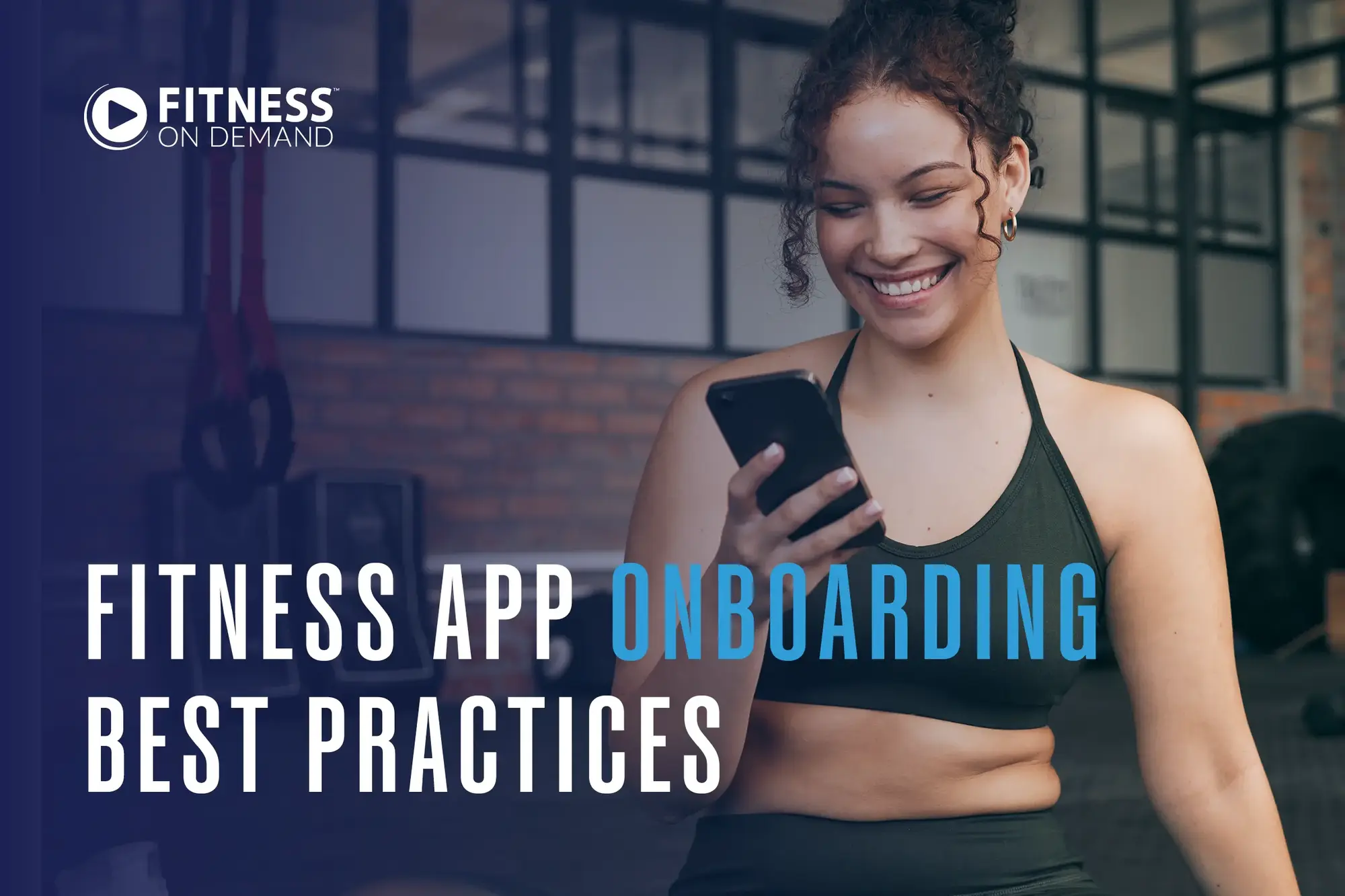Whether you run a health club or manage an apartment community, that first app interaction shapes a user’s entire fitness journey with you. Is it welcoming, easy to use, motivating, or does it leave them confused, overwhelmed, or unengaged?

Smart onboarding with platforms like the Flex App by Fitness On Demand makes user engagement easy from day one. Let’s break down how great fitness app onboarding guides users from download to daily use through smart design and personalization.
Your Brand, Your App
Create community through competition with a custom branded app of your own. Explore challenges, nutrition guidance, fitness programs, and more with the Flex App.
Why Fitness App Onboarding Is the New Retention Battleground
You only get one shot at a smooth start, and many fitness apps miss the mark. Clunky design, too many steps, or no personalization can make users leave before their first workout. Common onboarding missteps can drive mobile users away. When the process feels complicated or overwhelming, 89% of potential users say they’re likely to switch to a different solution.
Long-form content at the start can be a barrier, and a lack of customization makes the experience feel generic and forgettable. If users don’t immediately see key features, such as on-demand classes or equipment integration, they may not return. Skipping interactive tutorials is another common mistake, though a simple walk-through can boost confidence and encourage early engagement.
User preferences back this up. In a recent survey shared by James Evans, Co-founder and CEO of Command AI, 81% of users said they enjoy onboarding experiences with step-by-step tours. Another 54% prefer walkthrough videos, 50% rely on help documentation, and 43% find onboarding checklists helpful. Only 30% enjoy chatbots, and 86% said pushy feedback prompts are simply annoying.
Keeping this in mind, avoiding common pitfalls can enhance the overall user experience. This sets the stage for lasting retention and a more valuable digital fitness offering.
Fitness App Onboarding: Proven Best Practices to Boost User Retention
A well-designed onboarding experience introduces users to your app, laying the foundation for long-term involvement. Here are the best strategies to stay connected and keep users coming back.
Engaged From Day One
The first few minutes of using the app determine whether people feel motivated or lost. The key is helping them see value fast by removing obstacles and letting them start a workout right away. For instance, Fitness On Demand’s Flex App allows users to instantly begin thanks to its intuitive interface and efficient mobile app onboarding flow. Learn about the FLEX App and how it can elevate your fitness offering.
Another effective approach is to include a Quick Start option so users can begin using the app without filling out multiple forms. You can also add a Recommended for You tile featuring a short, popular class that doesn’t require setup — just tap and go. Less effort upfront makes connected fitness easier and more consistent to access on the go.
Understand the User’s Mindset at First Launch
First-time fitness app users are curious but cautious, so make them feel welcome. If the navigation is unclear or the steps feel overwhelming, many will drop off before ever completing a workout.
Treat an online onboarding experience similar to a gym tour. Provide just enough guidance to make them feel welcome, without overloading them. Use language that speaks to common goals, such as building strength or fitting workouts into busy days.
Allow users to self-select what best describes their intent. Tooltips and floating hints or a short “coach” voiceover can walk them through the basics in a low-pressure way. Include simple instructions on how to add workouts to a fitness app so users can quickly personalize their routine.
Keep the flow intuitive by breaking it into small, satisfying steps. If user behavior analytics show common drop-off points, adjust the design to keep the app experience smooth and encouraging. Also, invite instant feedback after their first session. Something as simple as an emoji rating or short survey can provide valuable insights into their experience during those crucial first moments.
Fitness App Onboarding Starts With Setting Expectations
Users feel more confident when they know what to expect. A short overview of the app’s core features, like class options, device compatibility, or equipment pairing, can help.
You can keep users on track by showing a short checklist or step indicator. This is so they know how close they are to being fully set up. A “What’s Next” message after each step helps frame the user journey ahead. Adding brief visuals, screenshots, or short animations can simplify complex features such as syncing with in-gym equipment.
These small touches make the experience feel more intuitive, while reducing support needs later on.
Personalization Begins at First Touch
Generic experiences rarely drive lasting engagement, which is why virtual fitness for gyms needs to be personalized. From the fitness app onboarding screen, offer a quick preferences setup for a personalized experience. This helps collect key details, including fitness goals, preferred class types, or experience level. It also allows you to tailor content to user needs, building relevance and trust.
Offering a short “build your plan” setup or fitness quiz helps tailor the journey from the start. Simple questions like “How often do you work out?” or “What motivates you?” can personalize content and showcase relevant content. Personalized welcome messages further reinforce this connection.
Show, Don’t Tell: Let Users Experience the Value
Rather than explaining everything through text, guide users with short tutorials, demo workouts, or walk-throughs. Giving them something to do right away, like trying a featured class, builds interest and demonstrates the app’s value.
Users who see immediate results, even small ones, are likely to continue using the app regularly. Consider offering a “First Win” feature, such as a beginner workout that unlocks a digital badge or progress marker. Interactive overlays that highlight features such as timers, progress trackers, or casting options as users explore also keep the experience active.
Customize the Experience With White-label Power
For gyms and apartment communities, branding matters. A white-label app, like the Flex App by Fitness on Demand, reflects your identity, reinforces trust, and connects the experience to your physical space.
When users see your logo, your content, and your voice within the app, they’re more inclined to associate the value with your brand, not just the software. Consider tailoring push notifications using your brand’s tone, whether friendly, energizing, or motivational. Create community-specific programs or apartment-based wellness series to reinforce belonging and boost local engagement.
Build Habits With Subtle Psychology
User retention rates depend on habit formation. Simple strategies, including workout streaks, achievement badges, and encouraging notifications, help users stay on track without feeling pressured.
Celebrating small wins, such as completing a weekly goal or logging in consistently, creates a positive feedback loop that drives long-term usage. Add in-app nudges like “You’re halfway through your weekly goal!” or a progress ring that fills with each completed workout.
Use behavioral cues such as time-based reminders to encourage regularity and form lasting routines. For instance, a pop-up like “It’s time for your usual 6 PM session” can gently remind users to stay on track and build consistent habits.
Integrate Social Features Early to Foster Community
Connection builds commitment. Offering social tools early to invite friends, join challenges, or share progress helps users feel that they’re part of something bigger.
For multi-family properties, this can also drive engagement in shared fitness spaces through app-powered group workouts or resident challenges. Leaderboards, team goals, and shared achievements can amplify motivation and create friendly competition. A Workout With Friends challenge can make the experience more interactive, social, and sticky.
Make Fitness App Onboarding Seamless Across Devices
When it comes to fitness app training, users often start on one device and continue on another. Whether it’s switching from a smartphone to a smart TV or tablet, the app onboarding experience should remain consistent and easy.
Ensure preferences, progress, and profiles sync effortlessly so users can continue using the app anywhere, anytime.
Common Onboarding Mistakes to Avoid
Even branded fitness apps can lose users if the onboarding process isn’t built with clarity and momentum in mind. These overlooked mistakes often stall engagement before it begins.
- Confusing instead of guiding: A flashy interface won’t help if users don’t know what to do next. Onboarding steps should lead them with clear goals, not overwhelm them with features all at once.
- Treating all users the same: A first-time gym goer and a fitness enthusiast have different needs. If onboarding fails to adapt to the experience level or motivation, you miss the chance to connect early.
- Skipping the why: Features are important, but purpose matters more. Use screens early to show how the app fits into users’ routines and helps them achieve real-world results.
- Ignoring motivation: Users don’t just need instructions; they need encouragement. A welcome message, a quick win, or a progress milestone can spark momentum from day one.
- Assuming onboarding ends at login: Effective onboarding extends beyond the first session. Timely nudges, tips, and check-ins in the first week are key to turning new users into regulars.
Flex App by Fitness On Demand Lets You Engage Members Anytime, Anywhere
Whether you run a gym or manage a residential community, the Flex App by Fitness On Demand makes onboarding easy and efficient. It helps your members stay active, motivated, and on their own schedule. With a friendly design and access to on-demand and livestreamed workouts, nutrition, and more, users can stay on top of their wellness wherever they want.
You can brand it your way, supplement it with existing fitness amenities, and present personalized class picks based on each user's goals. It’s a smart, unified way to take your wellness program beyond the walls.
Level up your fitness offering with smooth onboarding through the Flex App by Fitness On Demand.

Author
Luke Miska
Luke Miska is a results-driven business management visionary with a stellar record developing operationalizing strategies, experiences and measurable results that engage teams and customers to lead healthier lives. He leverages his passion for customer-centric strategies and aligns goals between customer needs and organizational priorities, catalyzing business success.
